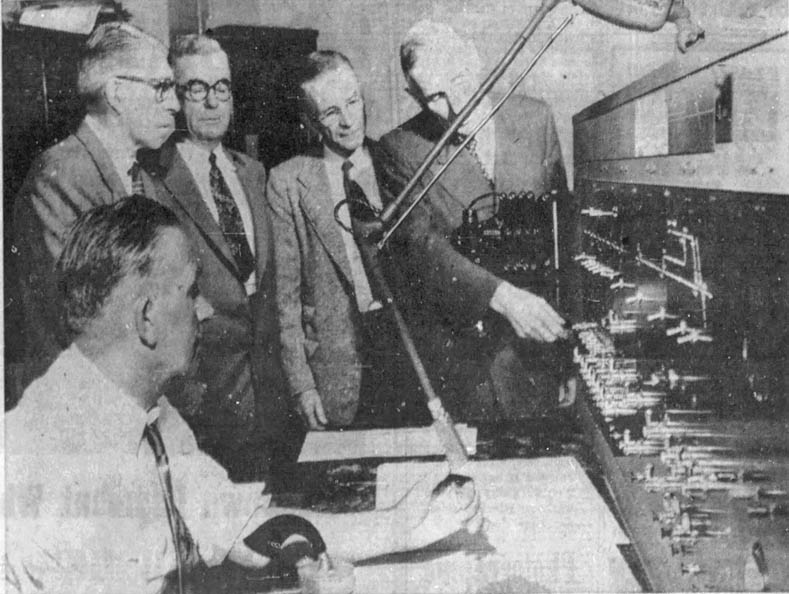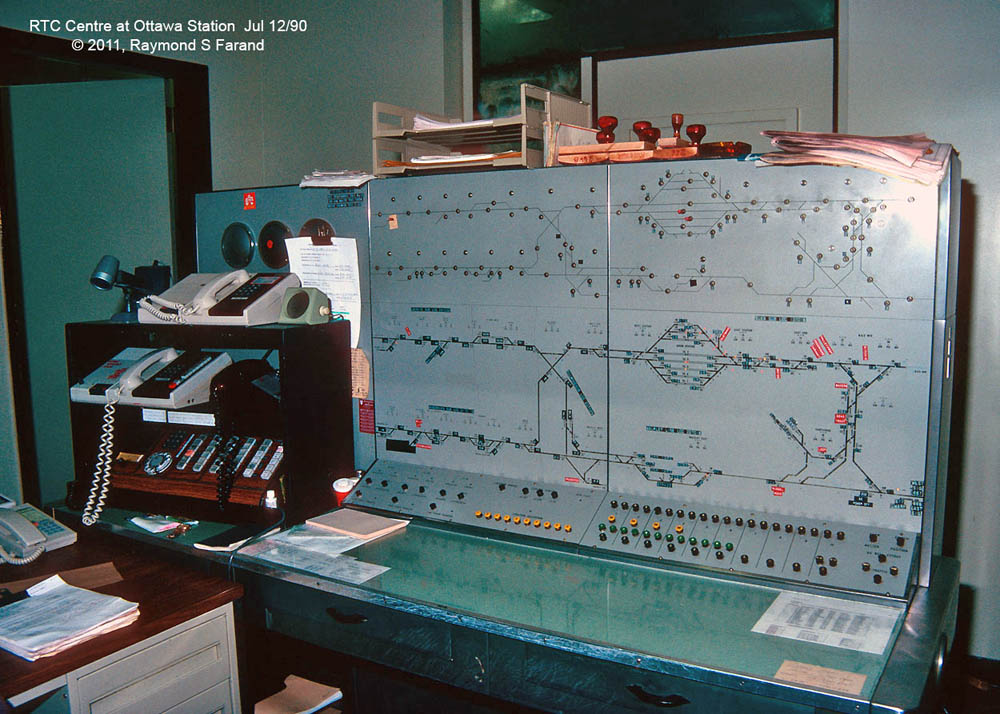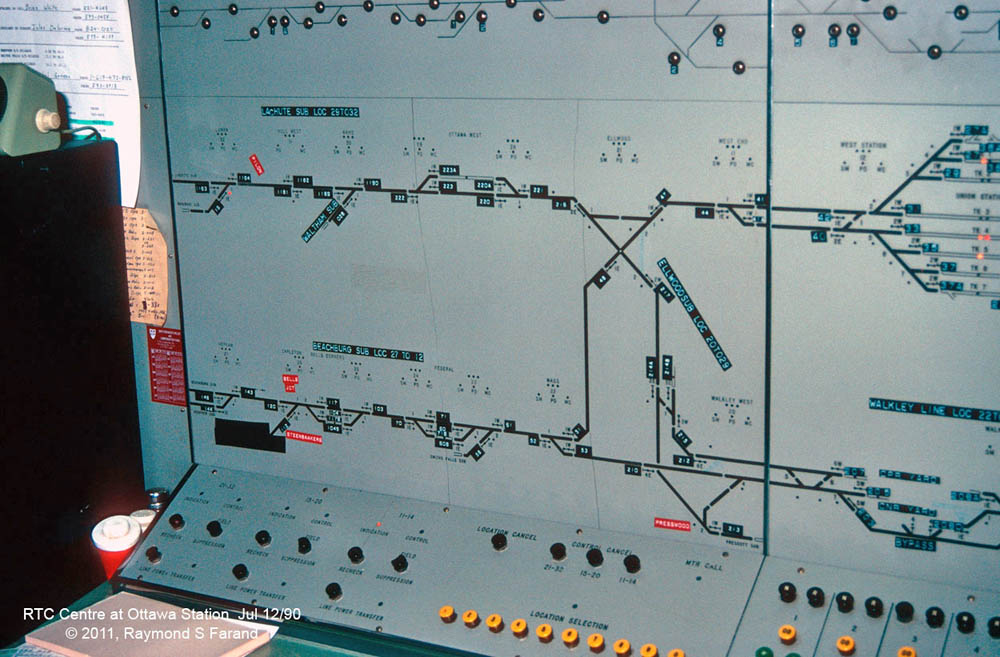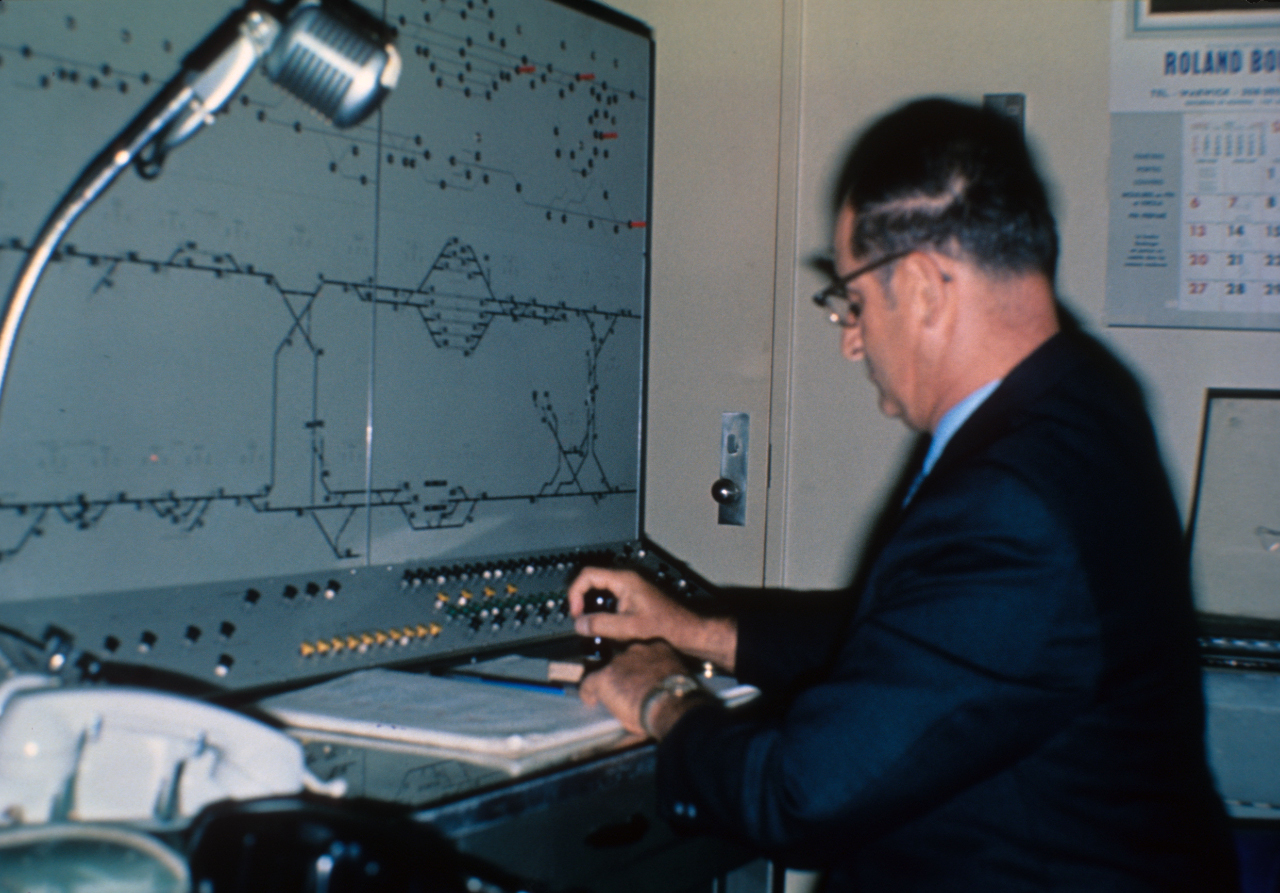| CTC Panels in Ottawa The
original CTC (Centralized Traffic Control) signal system in the Ottawa area came
into use on 9 June 1955. It was located in the Union station.
 This shows the inauguration of the CTC panel in Ottawa. The picture also shows Austin Cross of the Citizen and Silas Wass who designed Walkley Yard and who gave his name to the Junction of the Walkley Line and the Beachburg subdivision. From David Jeanes December 2019 I knew that the man with his hand on the panel was Sy Wass, but I had a hunch about the young man on the left. Sure enough, it is Roger Spack, who had joined CN as a signal engineer a couple of years before, after first working on the TH&B after university. Roger and I just had a long talk about the picture. He remembers it very well, but not the names of the other people, except Sy Wass, civil engineer for the Railway Relocation project, and George Dunn, beside Roger with the glasses, who was the Ottawa Division Superintendent. This installation took over the manual interlocking of the NYC with the Alexandria Sub at Hawthorne, but it was then discontinued by a board order after the NYC abandonment two years later in 1957.  David Jeanes prepared the above annotation of the 1955 CTC panel. This
covered only CN trackage (about 28 miles) but not the Riverside to
Union Station section. Walkley Yard was also outside CTC and there was
no bypass track then. The white arrows pass through the various switches for each of the 15 controlled elements among the 7 named locations on the diagram. From the Ottawa Citizen Friday 10 June 1955 (picture, caption and article)  The
slick streamliner Super Continental of the Canadian National Railway
was brought into Ottawa by push button yesterday. A joint project
by the Federal District Commission and the Canadian National Railways
has resulted in a million dollar installation down at the Union
Station. Here some 28 miles of railway track in the Ottawa
terminals are now all controlled from this panel. here's No. 2
coming in from Bells Corners while everybody tries to help.
Standing: left, Austin Cross, Citizen, G.T. Dunn, CNR superintendent,
Alan K. Hay, general manager, FDC; and silas Wass, railway consulting
engineer for the FDC. Seated is operator J.R. Sine. Push-Button Railroading In Ottawa It's
fun to play God to trains. Down at the station an alphabetical
combination called CTC and worked with lights has the power to stop the
Super Continental Limited, it can tie the Ottawa terminals in knots, it
can control 400 people miles away, it can make two mile long freight
trains meet effortlessly in a 40 below blizzard. Centralized traffic control has come to Ottawa. Under the joint auspices of the Federal District Commission, which paid the shot, and the Canadian National Railway when [sic] operates the CTC board, a brand new train control for the Ottawa area is now a realization. Now In Effect It
went into effect on Thursday afternoon in a small room at the Union
Station, while Alan K. Hay. general manager of the FDC looked on with
G. T. Dunn, superintendent of the Canadian National. Looking on
knowingly also was Silas Wass, railway consulting engineer, FDC. J.R.
Sine was the operator. He kept chattering with his key in morse to
parties along the line. To begin with, the Canadian National's crack train, the Super Continental, was rolling smoothly out in Carleton County some place. Her green gold and black contours were sliding through the June landscape. But in a hot room on the second, floor of the CNR offices in the depot, were other officials trying to bring her in. Thus all The Clitizen had to do was to flip this or flick that, and for all her speed the "Super" would have to grind to a stop. Push button railroading had come to the Ottawa terminals. This intricate system, ultra modern in design and as simple as pie, covers a large triangle bounded by Riverside, Hawthorne and Federal, and extends from Riverside to Hawthorne and from Hawthorne to South March, Thus when No. 2 clipping through the bosky dells and cool pastures of Carleton County, the CTC was chaperoning this hot shot transcontinental alt the way. "Past Nepean," cried one, and a light came on. "She's at Bells Corners," and another light came on. "Federal." yelled an employe, as the Super Sneaked across the. CTC board in lights. Then came the yards and the bridge at Pretoria Avenue. In a minute or so it was possible to see her lights on the board then look out the window and see her back into the depot, right on the advertised time. According to Walter Bowker, spokesman for the FDC, "the new system is an integral part of the FDC current railway location project to transfer CNR yard operations from the cross town tracks to new yards along the Walkley Road at the southern edge of the Capital." It was further announced by William Gilbert of the Canadian National that the present cross town tracks right of way is being utilized for a crosslown limited access highway, the "Queensway" which will run from the Montreal Road at Green's Creek on the east, to rejoin Highway No. 17 at South March west of the Capital. Good progress on the new Walkley Road terminal was predicted by G.T. Dunn, superintendent. He said that an estimated 20 crews would sooner or later be working out of the new terminals on the Walkley Road in the near future. He prophesiad that the new yard office might be ready by August 1. This he indicated, would mean the transfer ef an estimated 25 men on the three different shifts. One of the passing tracks at Federal is to have a capacity of 105 cars while another at Bell's Corners will hold 108. This new push button railroading is the beginning of the end for the Union Depot, even though it may take some years for the cramped old terminal to go. Parking problems, said one observer, will automatically drive the passenger trains to Walkley Road. "It's just a matter of time," he declared.  The Ottawa Terminals panel was taken out of service, and functions transferred to Montreal on July 14, 1990. The first three pictures were taken by Ray Farand two days before the panel was taken out of service.     Dave Knowles provided this picture of the 1967 panel soon after opening.  Ottawa
Terminals CTC panel, Marcel Labelle, Dispatcher, using a form stamp
before making an entry in his Train Order Book,
CN
CTC Panel Desk C, Dispatcher Raymond Leclerc, Belleville, Ont.
date
This is the CN CTC Panel
that controlled
the Alexandria Sub.unknown. CN Photo, Doug Wilson collection. At the time of the photo, Ottawa was part of the Rideau Area with headquarters in Belleville, ON and formed part of the St. Lawrence Region. This panel was located in the CNT building which was on the north side of the tracks just west of the station. The picture dates from the late 1960's/early 1970's. This particular panel was known as 'Desk C' Belleville. It controlled CTC on the Alexandria Sub as far as Hawthorne; and the CTC on the Kingston Sub from mile 10.9 to 39.8 i.e. Dorval to Coteau West. The dispatcher was also responsible for movements on the Vankleek Subdivision (it still had subdivision status at the time) Looking at the picture more closely, on the display board in front of the dispatcher, the top line is the single track Alexandria Sub with its sidings. If you look just to the left of the dispatcher's neck you can see a train entering a siding. The picture is not quite sharp enough but it would be Casselman, with the first two south side sidings to the left being Carlsbad and Limoges. The next two visible north side sidings would be Maxville and Alexandria, assuming the display has Hawthorne on the dispatcher's left and Coteau to the right. Below that is the double track Kingston Sub with its 4 track locations. The train dispatcher is recording information on his yellow coloured train sheet. In the near foreground is the pen graph. It records when a signal is cleared at a control location for an approaching train and when the signal is accepted. The dispatcher will join the dots with a pencil and write the train number along the line depicting the progress of a train.
|

Updated 5 January 2026